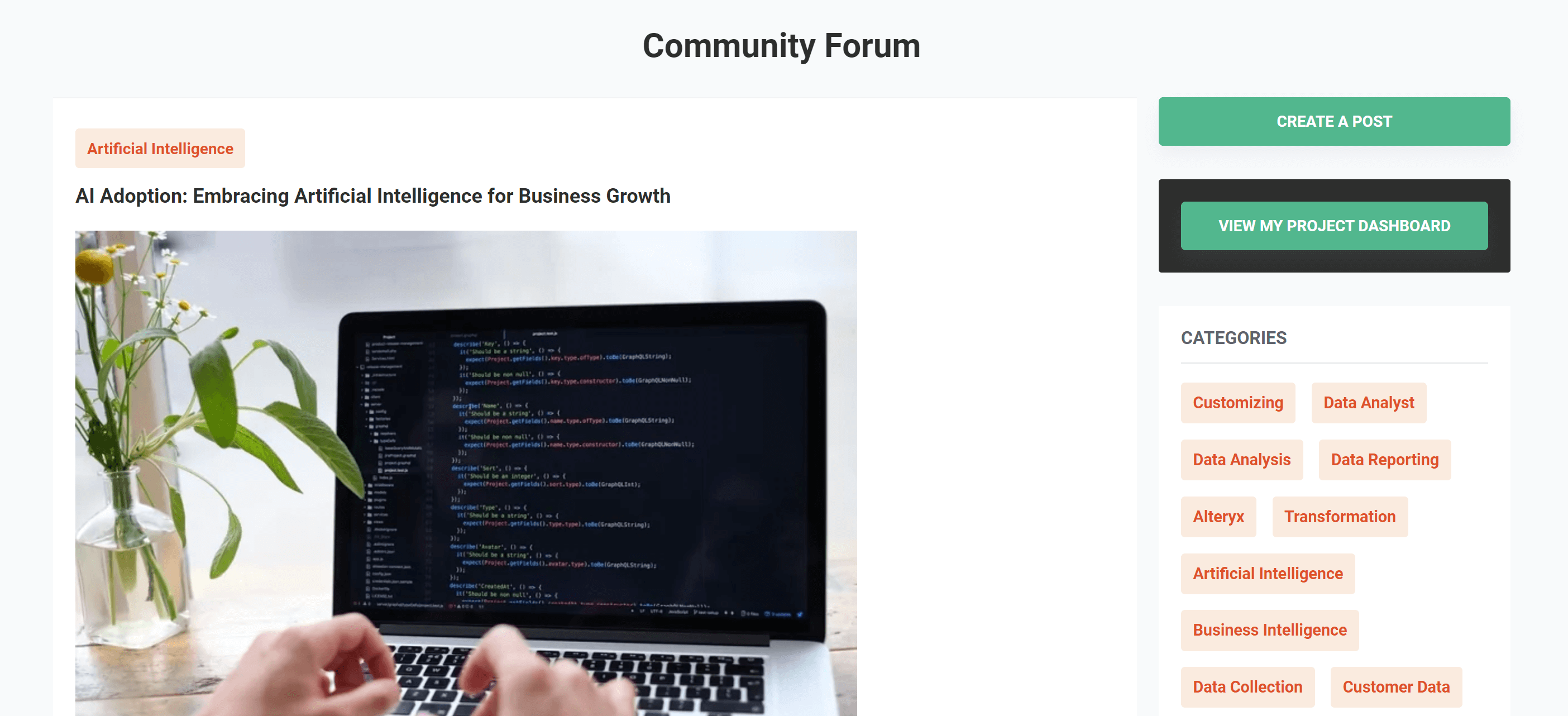The Ultimate Guide to Cloud Computing and Analytics

Table of content
What is Cloud Computing?
Cloud Computing Services
Public Cloud vs. Private Cloud vs. Hybrid Cloud: Understanding Your Options
Cloud Computing Benefits
Cloud Security
Conclusion
Cloud computing stands as one of the most pivotal IT trends of the 21st century. Over the past two decades, it has transformed enterprise IT, leading most organizations to adopt a “cloud-first” strategy for their technology needs. This surge in cloud adoption has spurred significant growth in related fields, such as cloud analytics and cloud security.
In this ultimate guide, we delve into everything you need to know about cloud computing, including its functionality, the distinctions between public and private clouds, and the advantages and limitations of various cloud services.
What is Cloud Computing?
Defining cloud computing can vary, but the most widely accepted definition comes from the U.S. Department of Commerce’s National Institute of Standards and Technology (NIST). According to NIST, cloud computing is “a style of computing in which scalable and elastic IT-enabled capabilities are delivered as a service using Internet technologies,” a summary also endorsed by Gartner.
NIST outlines five “essential characteristics” that define all cloud computing environments:
- On-Demand Self-Service: Cloud computing offers on-demand self-service, allowing consumers to provision computing capabilities, such as server time and network storage, as needed, without requiring human intervention from the service provider.
- Broad Network Access: Broad network access ensures that cloud capabilities are accessible over the network and through standard mechanisms, enabling users to connect from various devices and locations.
- Resource Pooling: Cloud systems utilize resource pooling, where resources are shared among multiple consumers through a multi-tenant model. This means physical and virtual resources are dynamically assigned and reassigned based on demand, providing location independence and high resource availability.
- Rapid Elasticity: One of the standout features of cloud computing is rapid elasticity. This allows capabilities to be quickly scaled up or down according to demand. To users, this elasticity appears as though there are unlimited resources available, which enhances flexibility and responsiveness.
- Measured Service: Cloud computing employs measured service to automatically control and optimize resource usage. This is achieved through metering, which varies depending on the service type (e.g., storage, processing, bandwidth). Cloud vendors are required to provide a Service Level Agreement (SLA) to codify technical aspects and ensure transparency.
Additionally, cloud computing integrates several key technologies that enhance software development efficiency, such as containers. Containers enable consistent application deployment across different computing environments through operating system virtualization.
Cloud Computing Services
Cloud computing encompasses a diverse range of services, but the NIST definition highlights three primary cloud service models: Software as a Service (SaaS), Platform as a Service (PaaS), and Infrastructure as a Service (IaaS). These models form the backbone of cloud computing, though many vendors offer additional services under the “as-a-service” umbrella, including Database as a Service (DBaaS), Disaster Recovery as a Service (DRaaS), Function as a Service (FaaS), Storage as a Service (SaaS), Mobile Backend as a Service (MBaaS), Security as a Service (SECaaS), Networking as a Service (NaaS), and more.
Collectively, these offerings are often categorized as “everything as a service” or XaaS. However, most of these specialized services still fall under one of the three core categories.
Software as a Service (SaaS)
The Software as a Service (SaaS) model allows users to access applications via the web. In this setup, application data is stored within the software vendor’s cloud infrastructure, and users can connect from any internet-enabled device. Unlike traditional software models, which involve a one-time purchase, SaaS operates on a subscription basis, either monthly or yearly.
The SaaS market is experiencing rapid growth, projected to expand from $273.55 billion in 2023 to $908.21 billion by 2030, with a compound annual growth rate (CAGR) of 18.7 percent. Major players in the SaaS market include Salesforce, Microsoft, Google, ADP, SAP, Oracle, IBM, Cisco, and Adobe.
Infrastructure as a Service (IaaS)
Infrastructure as a Service (IaaS) provides access to fundamental computing resources such as storage, networks, and other infrastructure elements. Using IaaS is akin to utilizing physical hardware like servers or storage appliances, but it is managed through the cloud rather than a traditional data center.
The IaaS market, valued at $118.43 billion in 2022, is projected to reach $450.52 billion by 2028, maintaining a CAGR of 24.3 percent throughout the period. Leading public IaaS vendors include Amazon Web Services (AWS), Microsoft Azure, Google Cloud, IBM SoftLayer, and VMware vCloud Air. Additionally, companies like HPE, Dell Technologies, Cisco, Lenovo, and NetApp provide infrastructure for private IaaS setups.
Platform as a Service (PaaS)
Platform as a Service (PaaS) bridges the gap between IaaS and SaaS. Unlike SaaS, PaaS does not deliver end-user applications; instead, it provides a comprehensive platform for developers to build, deploy, and manage applications. PaaS solutions offer more than just infrastructure, including tools and services that streamline the development process.
The global PaaS market, currently valued at $61.42 billion, has grown by 9.8 percent from the previous year. Prominent PaaS vendors include Amazon Web Services, Microsoft Azure, IBM Bluemix, Google App Engine, Salesforce App Cloud, Red Hat OpenShift, Cloud Foundry, and Heroku.
Public Cloud vs. Private Cloud vs. Hybrid Cloud: Understanding Your Options
When it comes to cloud computing, the deployment model you choose can significantly impact your organization’s efficiency, security, and costs. The three primary cloud deployment models are public cloud, private cloud, and hybrid cloud. Each model offers distinct advantages and potential drawbacks, making it essential to choose the right one for your needs.
Public Cloud
The public cloud is perhaps the most widely recognized cloud deployment model. In this setup, cloud services are provided by third-party vendors and are accessible to any organization or individual. These services are hosted in the vendors’ data centers, which means that businesses can leverage extensive computing resources without the burden of managing physical hardware.
One of the biggest advantages of the public cloud is that it saves organizations from the cost and complexity of purchasing, deploying, and maintaining their own hardware. Instead, they pay a recurring fee to the cloud vendor, which handles all the infrastructure management.
However, using a public cloud does come with trade-offs. Organizations relinquish control over their infrastructure, which can raise concerns about security and regulatory compliance. To address these issues, some public cloud providers, like AWS Outposts, offer physical server racks that can be installed on-premises for enhanced security and compliance. Additionally, many vendors provide cloud cost calculators to help businesses predict and manage their expenses more effectively.
Private Cloud
The private cloud is tailored specifically for a single organization. It can be set up in two main ways: an organization can build and manage its own private cloud within its own data center, or it can opt for a hosted private cloud service provided by a third party. Private clouds are ideal for businesses that need a multi-layered infrastructure to ensure high levels of IT and data protection.
Unlike the public cloud, a private cloud offers dedicated infrastructure that isn’t shared with other organizations. This can address some of the security and compliance concerns associated with the public cloud, providing a more controlled environment. However, private clouds typically come with higher costs and require more effort to maintain compared to public clouds.
Hybrid Cloud
The hybrid cloud model combines elements of both public and private clouds into a single, cohesive environment. This approach allows organizations to benefit from the scalability and flexibility of the public cloud while keeping sensitive data and critical applications in a private cloud.
Hybrid clouds are particularly useful for handling scenarios like “cloudbursting,” where an organization uses the public cloud to manage spikes in demand that exceed the capacity of its private cloud. While hybrid clouds offer a balanced approach, managing this type of environment can be complex and often requires specialized tools and strategies.
It’s worth noting that many enterprises now operate in multi-cloud and hybrid cloud environments, reflecting the growing trend towards flexible and scalable IT solutions. Market researchers anticipate that this trend will continue, with hybrid clouds becoming increasingly common.
Cloud Computing Benefits
Cloud computing has revolutionized how organizations manage their IT resources, offering a range of benefits that traditional data centers struggle to match. Whether you’re using public, private, or hybrid cloud solutions, here’s a look at the key advantages of cloud computing:
Agility and Flexibility
One of the standout cloud computing benefits is its remarkable agility and flexibility. Cloud environments empower users to quickly provision the resources they need for new projects without the delay of traditional hardware setup. This means you can easily move workloads between servers and adjust resources as necessary, ensuring that your IT infrastructure adapts swiftly to changing demands. This flexibility is a game-changer for organizations looking to innovate and respond to market needs rapidly.
Scalability
Another significant benefit is scalability. Cloud computing excels in scaling resources up or down based on your application’s needs. Whether you’re experiencing a sudden spike in demand or a gradual increase, the cloud can handle it with ease. While scalability tends to be more straightforward in a public cloud due to its vast resources, both public and private clouds offer scalable solutions that far surpass traditional data centers in flexibility and efficiency.
Availability
Availability is another crucial advantage of cloud computing. In the event of infrastructure issues, data recovery is streamlined. Most cloud environments are designed with failover mechanisms, so if a server or storage device encounters a problem, your data can be quickly shifted to another resource without disrupting your operations. This high level of availability ensures that users experience minimal downtime and continuous access to their applications and data.
Location Independence
Location independence is a powerful benefit of cloud computing. Since cloud services are accessed via the internet, users can connect to their applications and data from virtually anywhere with a web-connected device. For businesses with remote or traveling employees, this means enhanced workforce mobility and the ability to maintain productivity regardless of geographic location.
Financial Benefits
Finally, let’s talk about the financial benefits. Generally, cloud computing services can be more cost-effective than maintaining traditional data centers. While the cost advantage varies depending on the cloud service model and usage, the ability to chargeback computing costs to specific business units is a significant benefit. This can greatly simplify budgeting and financial management, providing more control over IT expenditures.
In summary, the advantages of cloud computing—agility and flexibility, scalability, availability, location independence, and financial benefits—make it a compelling choice for modern businesses seeking to optimize their IT infrastructure.
Cloud Security :
When it comes to cloud computing, security concerns often center around public cloud services. Because public clouds are shared by multiple organizations, there’s a common worry that other users might access your data. Additionally, since enterprises don’t control the physical infrastructure where their data and applications are hosted, it’s crucial to ensure that cloud vendors implement robust security measures and meet compliance standards.
On the flip side, some security experts believe that public cloud services might actually offer stronger security compared to traditional data centers. Major cloud vendors invest heavily in security teams and cutting-edge technologies designed to prevent and respond to threats. Smaller companies, in contrast, might lack the resources to maintain such high levels of security on their own.
However, it’s important not to assume that cloud vendors alone are responsible for security. Ensuring data protection is a shared responsibility between the vendor and the user. Both parties need to actively engage in maintaining a secure environment to safeguard sensitive information effectively.
Conclusion :
Cloud computing has fundamentally transformed how businesses approach IT, offering unprecedented agility, scalability, and flexibility. Whether you’re navigating the choices between public, private, or hybrid clouds, understanding their unique benefits and limitations is key to optimizing your technology strategy. The advantages—ranging from enhanced scalability to location independence—highlight why so many organizations are embracing a “cloud-first” approach.
Yet, with these benefits come important considerations, especially regarding security. While cloud vendors are heavily invested in protecting your data, it’s crucial for both vendors and users to actively participate in maintaining robust security practices. By balancing these elements, businesses can harness the full potential of cloud computing while safeguarding their valuable information.
Get your data results fast and accelerate your business performance with the insights you need today.



